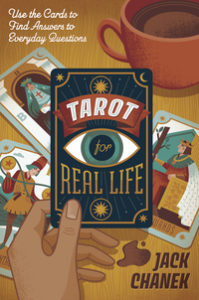Interpret Reversals with Ease
Tarot for Real Life: Use the Cards to Find Answers to Everyday Questions by Jack Chanek
Jack Chanek is an exciting new voice for Llewellyn. You may already be familiar with his name from his first book, Qabalah for Wiccans. Or perhaps you met him as I did, through his blog, particularly his articles on Baba Yaga.
In this book, Chanek takes a fresh approach to tarot by putting as much emphasis on the minors as the majors, hence bringing our attention to where the archetypal energies manifest in the real world. By weaving his teachings on the practical aspects of tarot reading through the suits, we experience a beautiful unfolding. The practice and sample readings throughout the book help us learn to divine useful answers to pressing questions.
Here is an example of his practical and accessible approach to tough tarot topics. Reversals are often challenging, but Chanek gives us some easy (and easy to remember) options (from the book):
A Reversed Card Is N.O.T. Itself
Here’s a handy (if somewhat cheesy) mnemonic device to help with reading reversed cards. The meaning of an inverted card is N.O.T. what that card means when it’s upright: Negated, Obstructed, or Tempered. Reversals in different contexts can mean any or all of these three things; figuring out which one is a matter of your personal judgment, and it’s something you’ll get better at with practice.
Negated
Sometimes, a reversal can signify the complete opposite of a card’s ordinary meaning. If you draw a reversed card that usually represents hard work and diligence, the reversal may well mean laziness and indolence. If a card ordinarily means community and social connection, a reversal can draw out themes of isolation and loneliness. This is the truest sense in which upside- down cards are “reversals” of their upright counterparts.
Typically, this interpretation works best with cards that deal in ordinary, mundane themes rather than cards that are dramatically positive or negative. The Seven of Pentacles in reverse can easily symbolize impatience and an unwillingness to keep one’s nose to the grindstone. This is because that energy is contained, somewhat, in the meaning of the upright card; patience and impatience go hand in hand. They’re part of the same essence. To take our “Yes, but…” mentality, it makes sense to say, “Yes, we’re talking about patience and hard work, but you’re being kind of hot-headed and entitled.”
A doom-and-gloom card like the Five of Pentacles in reverse, on the other hand, is unlikely to transform into a card of resplendent joy and good fortune. That’s simply too far removed from the central theme of the card. It may happen occasionally, depending on the reading, but most of the time, we wouldn’t say, “Yes, we’re talking about hardship and suffering, but everything looks bright and joyful.” It usually only makes sense to interpret a reversed card as negated when the negation still fits into the broader theme that the card represents.
Obstructed
Reversals can also indicate obstruction or blockage in the energy of a card—something is interfering with the card, preventing it from expressing itself the way it normally would. This could be an external circumstance, another person, or even an internal psychological condition on behalf of the person who requested the reading. A reversal can indicate that someone is of two minds about something, that they think they want what this card has to offer but that some part of them wants something different. The blockage can be out in the world or it can be from within, but something or someone is impeding this card from acting as itself.
This kind of reversal can also manifest as a temporal delay. Particularly when you draw a reversed card in the “future” or “outcome” position in a spread, it can mean that something is going to happen, but that there will be problems and delays to deal with before it does. A reversed card means blockages, difficulty, miscommunication, and frustration—but it tells us that ultimately, those things can be overcome.
Tempered
The third major way we can interpret a reversed card is that it tempers the meaning of the upright card. It’s the same basic meaning, but weaker and more toned down. Where the Ten of Pentacles could represent an inheritance or an endowment, the Ten of Pentacles in reverse might represent something smaller, like a birthday present from your grandmother. Where the Nine of Pentacles is the payoff after a long period of hard work, the reversed Nine might be a minor payoff like a spa day. In this sense, reversed cards can take the same energy that we ordinarily see in a card and shrink it down to a less dramatic scale. You’re still getting the same thing, but in a much smaller quantity.
This can be helpful in a reading because it shows us that not all cards are equal. If you have three cards and two of them are reversed, then the influence of the upright one is likely to be much stronger and more prodigious. The other two are still present, but they have less total effect on the outcome of the reading. Using reversals in this way allows you to see themes that are still present and relevant to the question you’ve asked, but that aren’t the dominant forces at play.










